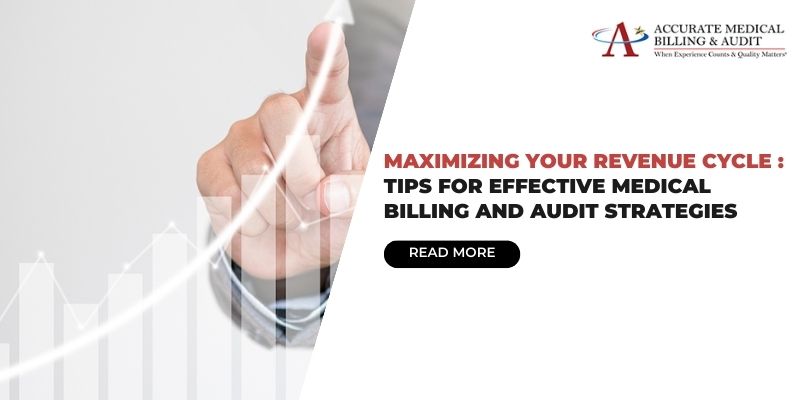Medical billing and audit techniques in healthcare firms are crucial parts of the revenue cycle. Increased patient satisfaction, better operational efficiency, and enhanced cash flow can all be the outcomes of a successful revenue cycle management strategy.
However, revenue cycle management is challenging and necessitates a thorough knowledge of payer policies, healthcare regulations, and billing standards. In order to maximize your revenue cycle, we’ll go over some successful medical billing and auditing tactics in this post.
Tips for Effective Medical Billing and Audit Strategies

1. Ensure Accurate Patient Information
Technology has the potential to greatly enhance revenue cycle management. A strong electronic health record (EHR) system that can automate billing and coding procedures must be implemented by healthcare companies. EHR systems can decrease billing and coding errors and increase claim accuracy.
Healthcare firms can track claim status and manage denials more efficiently with the use of EHR technology. The billing team might be notified by EHR systems to make the necessary modifications if billing information is insufficient or erroneous. Additionally, automated payment posting systems that may automatically post payments and produce patient statements can be used by healthcare companies.
2. Streamline Your Processes with Technology
Technology has the potential to greatly enhance revenue cycle management. A strong electronic health record (EHR) system that can automate billing and coding procedures must be implemented by healthcare companies. EHR systems can decrease billing and coding errors and increase claim accuracy.
Healthcare firms can track claim status and manage denials more efficiently with the use of EHR technology. The billing team might be notified by EHR systems to make the necessary modifications if billing information is insufficient or erroneous. Additionally, automated payment posting systems that may automatically post payments and produce patient statements can be used by healthcare companies.
3. Ensure Compliance with Regulations and Policies
To maintain efficient revenue cycle management, healthcare institutions must adhere to a number of laws and policies. Regulation and policy compliance can reduce legal and financial risks, as well as avoid fines and penalties.
Health Insurance Portability and Accountability Act (HIPAA) rules must be followed by healthcare organizations in order to safeguard patient data and privacy. To prevent claim delays and denials, healthcare institutions must also adhere to all laws and regulations set forth by the Centers for Medicare and Medicaid Services (CMS).
4. Monitor and Analyze Key Performance Indicators (KPIs)
Key performance indicators (KPIs) are essential metrics that healthcare organizations must monitor to ensure the effectiveness of their revenue cycle management process. KPIs can help healthcare organizations identify areas for improvement and measure their performance against industry benchmarks. Some of the critical KPIs that healthcare organizations must monitor include:
1.Days in accounts receivable (DAR)
2. Clean claim rate (CCR)
3. First pass yield (FPY)
4. Denial rate
5. Collection rate
Healthcare organizations must monitor these KPIs regularly and take corrective actions to improve their performance.
5. Conduct Regular Audits
For the purpose of finding potential compliance problems, coding errors, and billing errors, routine audits are crucial. To make sure that rules and policies are being followed and to find areas for improvement, healthcare companies must regularly undertake internal audits.
Internal audits can assist healthcare organizations in finding possible fraud, waste, and abuse areas so that remedial action can be taken to stop them. Additionally, in order to prevent claim delays and denials and to assure compliance with payer laws and guidelines, healthcare organizations must regularly perform external audits.
6. Implement Effective Denial Management Strategies
Denied claims can have a substantial negative impact on a healthcare organization’s revenue cycle. To avoid claim denials and manage denied claims effectively, healthcare companies must put in place efficient denial management systems. Regular trend monitoring, root cause analysis, and corrective action implementation are all essential components of denial management techniques. In order to swiftly challenge refused claims, healthcare companies must also have a strong appeals procedure.
7. Train and Educate Staff
Effective revenue cycle management calls for staff education and training. To ensure compliance with rules and policies and boost claim accuracy, healthcare institutions must regularly train and educate their billing and coding employees.
Updates on the most recent laws, rules, and policies, as well as coding standards and billing procedures, must be covered in staff training and education. The significance of precise documentation and coding, proper claim submission, and prompt follow-up with patient accounts must also be emphasized in staff training and education.
8. Outsource Medical Billing and Coding Services
For healthcare institutions, outsourcing medical billing and coding services might be a financially viable option. Healthcare businesses can lower overhead expenses and increase the precision and effectiveness of their billing and coding procedures through outsourcing.
Additionally, outsourcing can assist healthcare firms in staying current with industry developments, legislation, and policies. Healthcare businesses must, however, pick their outsourcing partners wisely and make sure they adhere to rules and guidelines.
Effective Revenue Cycle Management Goes Beyond a Healthcare Organization’s Finances

Effective revenue cycle management not only improves the financial health of healthcare organizations, but also enhances patient satisfaction. Patients expect timely and accurate billing statements, and delays or errors in billing can significantly impact their satisfaction. Healthcare organizations that prioritize effective revenue cycle management can improve patient satisfaction by providing accurate and timely billing statements.
Additionally, efficient revenue cycle management can boost a healthcare organization’s operational effectiveness. Reducing administrative tasks and giving personnel more time to concentrate on patient care are two benefits of streamlining the revenue cycle process. Healthcare firms can boost employee productivity and lower turnover by minimizing the time and effort needed for billing and coding procedures.
Healthcare firms need to keep up with the most recent industry developments and best practices in addition to the advice provided above. Healthcare firms must stay up with the most recent laws, guidelines, and technology developments because the healthcare sector is always changing in order to provide efficient revenue cycle management. To better the revenue cycle process and the patient experience in general, healthcare companies must also work in collaboration with their payers and other stakeholders.
Conclusion
Effective medical billing and audit strategies are critical components of a successful revenue cycle management process in healthcare organizations. By implementing these tips, healthcare organizations can maximize their revenue cycle and improve their financial performance.






I’ve been surfing on-line more than 3 hours these days, yet I never discovered any interesting article like yours. It…